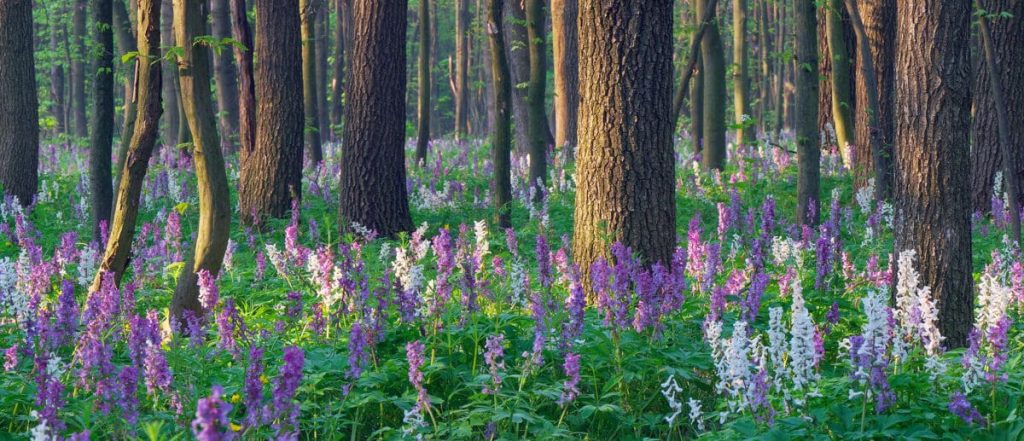
Introduction: What is Phenology?
Phenology is the study of the timing of life cycle events in the natural world, particularly as these events relate to seasonal and climatic changes. You may have noticed that certain flowers bloom around the same time every summer, that birds or other animals migrate at relatively predictable times, or that even when the weather hasn’t changed, certain natural cues alert you to an upcoming change of seasons. All sorts of plants, animals, and even fungi respond to environmental cues like temperature, daylight, and precipitation patterns that have been relatively stable for many generations of these organisms.
Although humans have observed the natural rhythms of their environments for millennia, the study of phenology has gained increasing importance in recent years, especially as scientists track the effects of climate change on natural systems and individual species. The timing of life cycle events can have profound effects on species interactions, and shifts in these events due to changing climatic conditions can lead to mismatches that disrupt ecosystems. For example, if warmer temperatures accelerate the life cycle and emergence of a particular pollinator, but the plant it relies on is not yet blooming, both the insect and the plant species could suffer population declines. Thus, phenology serves as a key indicator of how climate change is altering the natural world.
The Rhythms of Nature: Phenological Patterns
Organisms often demonstrate predictable patterns in response to seasonal changes. Many birds migrate south for warmer winters and back north for annual breeding seasons in temperate areas. Globally, there are numerous examples of large herbivores (or large swarms of small herbivorous insects) migrating to follow the emergence of new vegetation after rainy seasons. People who forage for wild mushrooms know the particular temperature and moisture requirements of their favorite species and the time of year to look for them. Many plants rely on day length as a cue for the changing seasons. For instance, fall colors in the leaves of some trees develop as a chain of biochemical reactions triggered by increasingly shorter periods of sunlight, preparing the trees for winter.
One of my favorite groups of organisms that mark the change of seasons are the spring ephemerals such as spring beauty or bluebells in hardwood forests. These are plants on the forest floor that quickly shoot up, flower, and set fruit before the forest canopy is fully leafed out in spring. They are “ephemeral” because they are only visible for a few weeks but put on a beautiful show of delicate pink, white, and purple blossoms. They take advantage of the resources available in the forest before most plants are actively growing and competing for sunlight, moisture, and nutrients. Once the tree leaves are fully expanded, the ephemerals die back to just their roots and wait for the next spring.
Botanists have kept records of these and other plants blooming for many decades. These and other natural history records are often available in publicly available digitized databases such as iDigBio. A few years ago, I worked with baccalaureate students to collect historical records from various parts of North America and examine relationships between plant life cycles and records of changing climatic conditions. We sorted through massive datasets of temperature, precipitation, day length, geographic location, and plant biometric markers of life cycle stages. Hundreds of dedicated botanists and citizen scientists across dozens of states and decades contributed to that dataset by keeping records of the regular phenology they observed around them.
The results of this research were fascinating. Some plants are more strongly impacted by climate change, depending on whether they usually flower very early in spring or later into early summer. Even the same species may have a variable response depending on geographic location. This makes intuitive sense; certain parts of the country and the world are hit harder by climate change effects. The timing of life cycle events varies across different latitudes and elevations, reflecting the diverse climatic conditions experienced by species that have adapted to gradual changes in climate over centuries. However, the rapid pace of contemporary climate change is challenging these adaptations, leading to shifts in phenological events that are unprecedented in their speed and magnitude.
Climate Change and Phenology
One of the most well-documented effects of climate change is the alteration of temperature regimes, which has led to earlier springs and delayed autumns in many regions. As climate change alters rainfall distribution, some regions may experience drier or wetter conditions than usual, impacting the timing of plant growth and the life cycles of the organisms that depend on them. For instance, prolonged droughts can delay the emergence of spring ephemerals, while excessive rainfall may result in increased susceptibility to fungal pathogens. Furthermore, extreme weather events, such as late frosts or unseasonable heatwaves, can disrupt regular phenological events.
Phenology Research: Unraveling the Complexities
To understand the complexities of phenology and its response to climate change, researchers employ a variety of methods, including field observations, remote sensing, modeling, and metadata analyses from historical data, as described above. Field observations are the cornerstone of phenological research, involving the meticulous recording of life cycle events over time. These observations provide valuable data on how species are responding to environmental changes and help identify trends that may indicate broader ecological shifts.
Remote sensing technology enables scientists to monitor large-scale patterns across vast regions. Satellite sensors can detect events like vegetation greening across different ecosystems, offering insights into how climate change is affecting these processes on a large scale. This, in turn, helps wildlife conservationists understand shifting migration patterns or changes in herbivore populations.
Modeling and forecasting are also essential tools in phenology research. By combining field data with climate models, scientists can predict how phenological events may shift under various climate change scenarios. These models help identify potential mismatches between species and provide a framework for developing strategies to mitigate the impacts of climate change on ecosystems.
Implications for Ecosystems and Society
The shifts in phenological patterns due to climate change have far-reaching implications for ecosystems, agriculture, biodiversity, and human health. In agriculture, altered phenology can affect crop yields, as the timing of planting, flowering, and harvest may no longer align with optimal growing conditions in a particular region. For example, fruit trees that bloom earlier due to warmer temperatures may be more vulnerable to late frost damage, reducing the yield of key crops.
Biodiversity is also at risk, as species that rely on synchronized life cycles may experience mismatches due to shifts in phenological events. For instance, if zooplankton bloom in an aquatic environment before the larval fish that depend on them have hatched, the zooplankton population could “boom and bust” without serving as that essential food source. These disruptions can cascade through ecosystems, affecting species interactions and the overall stability of ecological communities.
Human health can be impacted as well. Changes in the timing of insect life cycles can influence the spread of vector-borne diseases, as warmer temperatures may extend the active periods of disease-carrying insects like mosquitoes and ticks.
Conclusion: Adapting to a Changing World
As we adapt to a changing world, understanding phenology—both the predictable patterns and the out-of-sync perturbations—will help us grasp how organisms respond. The study of phenology reveals how deeply interconnected species are with their environments and how vulnerable these connections are to climate change. By monitoring phenological events, researchers can provide critical insights into the impacts of climate change on ecosystems and society, guiding efforts to mitigate these effects.
Explore how Unity Environmental University – Distance Education’s BS in Environmental Studies can empower you to make a lasting impact on the planet. Gain the skills needed to lead environmental initiatives and drive sustainable change—all from the flexibility of an online program.
Written by Dr. Michaeleen Gerken Golay with the assistance of AI language model ChatGPT (OpenAI, 2024).



